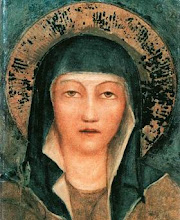The Benedictine "Little Black Habit"


It could be said that St. Scholastica was to nuns’ habits as to what Coco Chanel was to women’s fashion. Perhaps the beautiful, slimming black habit of the Benedictine nuns was Coco Chanel’s inspiration for the perennial “little black dress!”
Here is a brief overview of the Benedictine habit for both the monks and the nuns that I put together with help from this site:
Description and Use:
With slight modifications of shape in some congregations, the traditional monastic habit of the Benedictines consists of a tunic, confined at the waist by a belt of leather or of cloth; a scapular, originally a work apron, the width of the shoulders, that reaches somewhere between the knees and the hem of the tunic; and a hood (men) or wimple and veil (women) to cover the head. In choir, at chapter, and at certain other ceremonial times, a full, often pleated, gown with long, wide sleeves, called a "cowl" or "cuculla," may be worn by the finally professed over the ordinary habit. The word cuculla comes from the Greek word, koukoulion, for the great habit allowed to be worn after final profession of monastic vows.
The color of the habit is not specified in the Rule of St. Benedict, but it is conjectured that the earliest Benedictines wore white or grey, as being the natural colour of undyed wool. For many centuries, however, black has been the prevailing color, hence the term "Black Monk" has come to signify a Benedictine.
Insofar as the symbolism, many think that Benedict and Scholastica chose black as a reference to mourning. However, it is also probable that they chose black simply because the color was “en vogue” for Roman nobility at the time (from whence Benedict and Scholastica came). It looks like Benedictines were fashion-forward ever since the Order’s founding!
Benedictines also are big shoe fans, like many of us women in the world! The Rule specifically allows for stockings and light footwear for indoors. In fact, Benedictines traditionally received new shoes on the Feast of Michaelmas (celebrated September 29).
Don’t forget the “accessories”! On the day of their final profession, it is a tradition for many European Benedictine nuns to wear a beautiful silver crown over their veils. Abbesses typically wear a large cross pendant at their necks, and some of the choir nuns do too. They also wear beautiful Benedictine 20-decade rosaries at their waists as a constant reminder their Our Lady is always looking out for them.
Just look at the above pictures, and you will see that a woman certainly doesn’t have to check her fashion sense at the door of the cloister. She simply trades in her “little black dress” for a “little black habit”!
If there are any fashionistas reading this blog right now and smiling at what you’ve just read, please check out some of these awesome Benedictine monasteries. You never know what Jesus might have in store for you someday!









1 Comments:
MY FAVORITE SISTERS!!!!
Post a Comment
<< Home